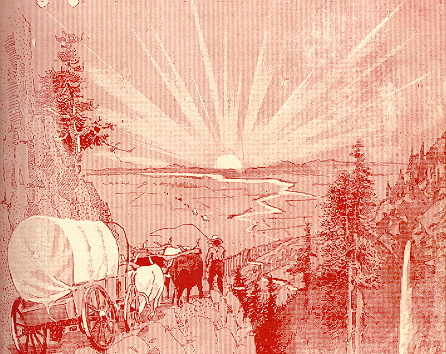
The idea of a “frontier,” of a place that is an edge between the known and the unknown, the settled and the wild, has a prominent place in American history. Sometimes it is a particular territory, such as the North American continent west of the Missouri River. It can be the idea of a place, something more ambiguous: a frontier is a place where you are on your own, where the rules are not yet made. The frontier can be a mental realm of new ideas, ideas about space and time and the origins of the world.
For many Americans, what was “the frontier” is, geographically, that land west of the Missouri River that is characterized as dry, perhaps even arid, where crops grow with a struggle and where cattle range freely, searching for water and feed. It once had Indians and buffalo, but those have vanished, leaving hard-handed sons of toil, some cowboys, a few miners, a few deer and antelope.
Oddly enough, this is not the frontier that could be found at the far western edge of our nation. The Pacific Coast is well watered, sometimes quite damp. California and the Willamette Valley of Oregon were long viewed as lands of agricultural plenty; but much of the coast was blanketed in huge and impenetrable forest. There were deer aplenty, but no buffalo. And the Indians? On the North Pacific Coast, they were viewed as a people whose culture was going or gone, whose society would soon cease to exist. Although Euro-American emigrants held a sometimes romantic and nostalgic attitude toward the local Indians, it was usually in conjunction with a view of them as essentially irrelevant people.
This exhibit looks at the Pacific Northwest, especially the Puget Sound country, and asks, What kind of Euro-American settlers came here? Why did they come? Were their motives similar to those who settled in the trans-Missouri West? Why did the Pacific Coast develop as a basically urban society, when the West was rural? Did settlers here think of themselves as being on a frontier? When they thought of the West, did they actually look east of the Cascades and the Sierras, rather than at themselves?
Did Puget Sound country settlers make use of the icons of the frontier story: the log cabin and the covered wagon, the intrepid pioneers who carved a living from the wilderness, the virtues of self-reliance, the dangers of Indians and the forces of Nature? Were these valid symbols here? Do those symbols still have power?
The University of Washington Libraries mounted this companion exhibit to accompany The Frontier in American Culture, a national traveling exhibition organized by the American Library Association in cooperation with the Newberry Library and funded by the National Endowment for the Humanities. UW history professor Richard White curated the exhibit. The exhibit toured through 1998 to sixty-six sites across the nation. It was shown at the University of Washington’s Allen Library in Seattle from December 27, 1996 to February 6, 1997.